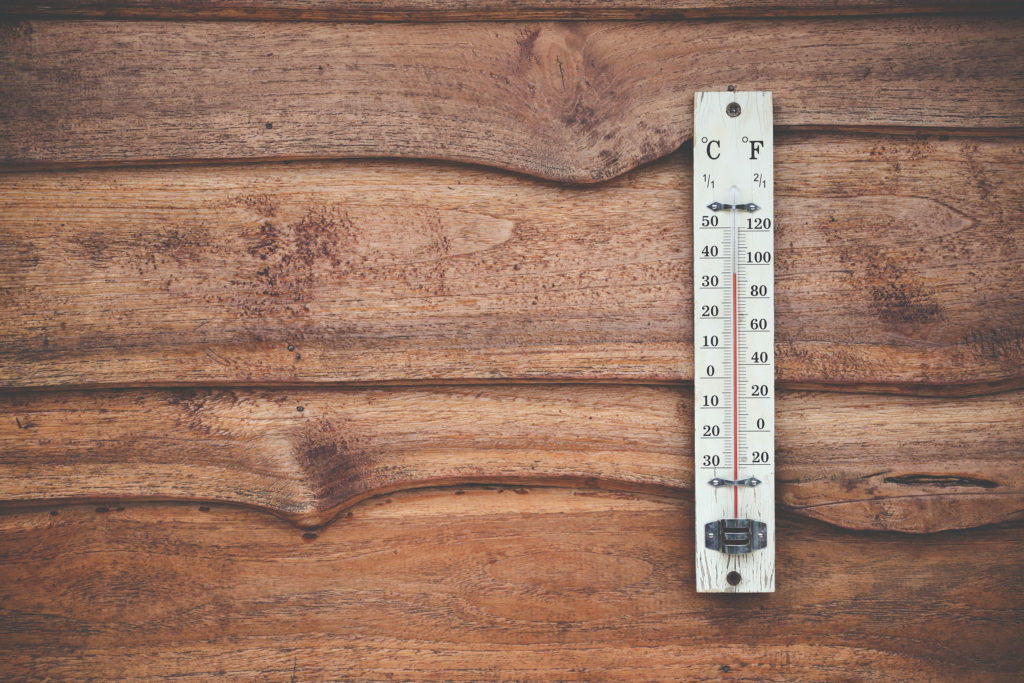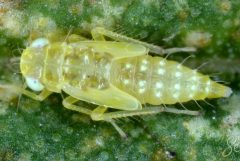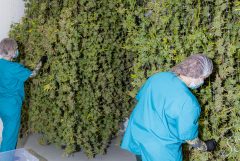Many people freak out when it comes to cold climates and growing weed, when in actuality, farming cannabis in cooler temps has a few huge advantages. Below we’ll share our 10 tips for growing cannabis in cooler conditions and demystify the stigmas that come with this type of farming. Cold does not have to equal misery!
- Indoor Growing in Cold Climates
- Outdoor Growing in Cold Climates
- 1) Choose the right strain
- 2) Maintain a consistent temperature
- 3) Humidity must be managed
- 4) Nutrients
- 5) Root health becomes a bigger player
- 6) Choose the right lighting
- 7) Timing is everything
- 8) Try force-flowering
- 9) Consider a flip-flop
- 10) Know the warning signs to make immediate adjustments
- To grow or not to grow
If you’re not fortunate enough to live in areas naturally conducive for an incredible outdoor growing operation, don’t get discouraged. Battling the elements is not only possible but has some surprising benefits, if done right.
Growing weed in cold climates doesn’t force you to compromise on quality either. In fact, there are several high-quality strains specifically bred to grow in cold weather. There a plenty of growers producing excellent crops despite living in cold weather areas.
If you live in a place where you experience the best and worst of all four seasons, the only thing to stop you from growing is your willingness to get a little creative.
You’ll also need to decide whether to grow indoors or outdoors, let’s dive into that first.
Indoor Growing in Cold Climates
Growing cannabis indoors seems like the logical plan if you live in an area with colder climates. Battling with the elements — below freezing temperatures, frost, torrential downpours and violent winds — become a minimal concern. But there can be some disadvantages to taking your growing operation indoors.
You may have space limitations. If you’re not fortunate enough to have a basement or empty storage room, you’ll need to put some serious thought into what space can be used most efficiently. The good news is that it is possible to generate decent yields even if you have to grow weed in a small space.
Consider the number of exterior walls when deciding which room to convert to a grow space. It’s important to pay attention to how cold the room gets at night when the temperature can dramatically drop. If your area tends to have significant drops, extra insulation may be required.
That’s another factor to include in your cost analysis. An indoor operation will require additional supplies and equipment which means additional expense for the start-up process.
Sometimes it’s better to have a few limitations and be able to control your growing environment, than to experience a total crop loss due to some unpredictable weather.
Outdoor Growing in Cold Climates
Are you dead set on doing your cannabis growing outside in a natural environment? Well, the good news is that it is possible in colder climates.
The first obstacle is selecting the right growing site. Your plants are at the mercy of the light they receive from the cycles of the sun. To choose the best location you need to understand the proper ratios of light and dark during the different growth stages.
Of course, the weather will always present its own set of difficulties. Make sure you have a plan-of-action for protecting your plants from harsh weather.
Another potential hazard is garden pests. Rabbits, deer, etc. if you live in a more remote area. If you live in a more urban area the “pests” to consider are of the nosy-neighbour variety. Extra steps may need to be taken to ensure privacy.
Despite the obstacles, growing cannabis outside is an extremely rewarding experience. Many professional cultivators insist that cannabis grown outdoors comes with stronger aromas and better-developed flavors, and guarantees a better high.
After weighing the pros and cons, the first step is to choose which location (indoor or outdoor) works best for your situation. The second is to prepare for the extra steps that factor into growing weed under less than optimum conditions.
So, here are our 10 tips!
1) Choose the right strain
Look for strains labelled with a Cool/Cold designation. These are specifically bred for outdoor growing. They are capable of flowering even in northern latitudes.
Choose Indica strains over Sativa strains. Sativas are normally bred with tropical genetics and require warmer climates. Strains bred with genes from Afghanistan, the Netherlands, Canada, and the Himalayas do well in cold-temperate climates.
Breeders have created a multitude of autoflowering seeds that do well in northern climates. They are popular for growing operations with outdoor facilities because their maturation is not inhibited by the length of day.
Our catalogue of Amsterdam-bred seeds lists some of the most weather-resistant, enduring seeds available. Holland’s Hope, Afghan, Early Bud, New Purple Power, and Swiss Miss have the potential to grow just about anywhere.
2) Maintain a consistent temperature

Changes in temperature from daylight hours to nighttime can be drastic in cold weather climates. Maintaining a consistent temperature can mean the difference between widely-spaced internodes and robust, compact nodes.
Keep temperature fluctuations to a minimum. Strive for a temperature gap no greater than 2-4 C (3.5-7F) of change. This is most important during the second and third weeks of the flowering period.
After the third week, it’s okay to allow the variance in temperatures to increase. But it still needs to be kept in check. Strive for temperature changes of no more than 10 C (18 F) during the remaining flowering period.
Unless you grow strains specifically engineered to withstand dramatic hot or cold temperatures, always be aware of the environment. A practical way of thinking about temperature is to consider how you feel.
If it seems too hot for you, it’s too hot for your plants. Conversely, humans do not fare well when exposed to freezing temperatures. If you feel a big chill, warm it up for your plants.
Temperature is the most critical element for growing weed. It impacts the size, quality, yield, growth rate, and overall health of your cannabis plants.
3) Humidity must be managed
Temperature and humidity are important factors to control for any pot grower, but cold-climate growers need to pay even more attention.
As a rule, warm air holds more water which means higher humidity. Cold air is often referred to as “dry” because it does not hold as much water. Cold air is usually low in humidity.
The relative humidity (RH) for maintaining the best growing environment varies based on the stage of the plant. For young plants, during the vegetative stage, the recommendation is to keep humidity levels between 40-60%.
If you have trouble maintaining the right humidity during your cold weather growing, here are a few simple tricks to raise the level:
- Use a spray bottle to manually add water to the air
- Moisten soil surfaces, but avoid over-wetting
- Drape dampened cloths or towels around the grow space
- A large capacity humidifier might be worth the investment
It’s important to note that plants are more vulnerable to a variety of molds in colder temperatures. If the environment is too damp, mold grows rapidly, destroying entire crops.
4) Nutrients
All cannabis plants need nutrients to grow healthy and produce large yields. Understanding how cold climates affect nutrient uptake is key to cultivating more potent buds.
In areas where the air tends to be dry (enter our old friend humidity) roots will compensate for the lack of moisture in the air by drinking more. Although this is an excellent survival technique it may also cause problems if a grower is not paying close attention.
More water intake through the roots also means those roots are pulling in more nutrients from the soil. If nutrient levels get too high (commonly called nutrient burn) leave tips will look burnt or entire leaves turn yellow.
On the opposite end, when roots are too cold they basically tighten up and do not allow for optimum intake of nutrients. Cold weather — usually anywhere below 10 C (50F) — results in a phosphorous lock-up.
Phosphorus is especially important during the flowering phase. The right amount of phosphorus increases the number of flowers.
As you can see, many of the issues that arise from growing in cooler climates can be corrected by paying attention to two things: Temperature and humidity.
5) Root health becomes a bigger player

If you’re growing outdoors in colder climates, you’re more than likely using a resilient, bred-to-be-grown outside strain. But it’s still important to be aware of the soil temperatures surrounding your plant’s roots.
The ideal outdoor condition is an area where plants are in full, direct sunlight the entire light cycle. This ensures the ground is warmed throughout the day, allowing the soil to retain the sun’s heat. The nighttime drop in temperature is not as drastic around the roots.
When growing indoors, avoid putting your pants directly on the floor. Take special consideration if it is in your basement or on a concrete slab. Concrete gets extremely cold, and the cold will leech into the plant roots.
Cold roots result in slowed growth and even disease. Don’t compromise your growing operation by neglecting the roots.
6) Choose the right lighting
In recent years the trend in cultivating lamps has shifted to the use of LED lights. They are great for energy efficiency and reducing heating costs. The issue lies with the low wattage emitted from the LEDs.
When temperatures drop, LEDs may not be enough to generate the heat needed for adequate growing conditions. At this point, your cannabis plants will suffer if you do not compensate. Try adding some HID lighting.
For outdoor cold-climate growing, cloud cover and rainy days also mean less light for the growing cycle. Many outdoor greenhouses utilize supplementary lighting to accommodate this.
7) Timing is everything
Northern climates have shortened summers, often lasting only 8-10 weeks. For that reason, many outdoor growers start plants inside.
The seeds germinate inside, and the plants are moved outdoors to receive natural sunlight during the vegetative and flowering stages. And harvesting is completed before unfavorable weather arrives.
If your locale forces a race against time, choose a cannabis variety that has a short flowering time.
Another technique for those with shorter growing seasons is to start plants from clones rather than seeds. By starting plants at a more mature stage you reduce the growth cycle length.
These more developed plants begin the vegetative growth phase sooner. They are ready to take advantage of optimal growing conditions right away.
8) Try force-flowering
It’s not uncommon for cultivators in cooler climate zones such as the UK or northern European regions to practice force-flowering. This is a way to make sure plants reach full maturity before autumn rains or winter cold arrives.
To force early flowering you must “trick” your plants into believing it’s later in the season. This is accomplished by artificially reducing direct sunlight hours to simulate shorter days. Shade plants with tarps or other lightproof material. They should be covered completely and receive no light for at least 12 hours.
Force-flowering during early or mid-summer not only allows you to harvest early, the benefits of summer temperatures will show by larger, more compact buds.
9) Consider a flip-flop
If nighttime temperatures drop too low, putting your plants at risk, consider switching it up. Flip-flop your light and dark cycles.
This requires a little more investment if you grow outdoors. You’ll need to purchase and wire lights. Weigh the pros and cons as the entire purpose of outdoor growing is to get that natural sunlight. But it could be worth it to save an entire crop.
For indoor gardens, it’s a bit simpler. Run lights during the night for twelve hours rather than during the day. The heat from your lights combats the colder temperatures. If you can guarantee complete black-out during the daytime, this is an excellent method for operations battling colder climates.
10) Know the warning signs to make immediate adjustments
As a grower, you need to be aware of the different signs that your plants are in trouble. Here are a few of the signs of sick cannabis plants:
- Curled edges on leaves
- Slowed plant growth
- Yellowing leaves
- Leaves have brown or burn spots
- Lower leaves drop off
- Petioles appear discolored, purple
Making immediate adjustments could literally be a matter of life or death.
To grow or not to grow
Well . . . that’s not really the question! Of course, you’re going to grow. You wouldn’t be reading this otherwise.
The real question is to grow in- or outdoors. And that’s in the eye of the grower.
From Colorado to the Netherlands to wherever you are, a cannabis growing endeavour is possible despite the conditions. All you need is the right tools, a can-do attitude, and the willingness to experiment and learn from mistakes.
Remember: ganja is a weed. And just like weeds of the non-smoking variety, it has evolved into a resilient, adaptable plant with a will to survive. With a little forethought and a keen eye, you can grow cannabis just about anywhere.
Have a success story about growing kick-butt crops in the cold? We’d love for you to share your experience and tips with the rest of us. Drop a line below.
Until next time . . . Happy Growing!















When growing indoors, avoid putting your pants directly on the floor.
Greetings from Canada! It is mid August and my robust bushy plants have enjoyed a super-warm summer. However, they will not have enough time to mature outside in their pots (no sign of flowers yet). Already seeing overnight lows of 9-10* C. Now they “sleep” in the shed at night.
“Forcing” with utter darkness would be difficult. Any reason why they can’t be finished over a couple of months indoors with my grow lights?
This was completely pointless its just a waste of time pointing out the obvious. Anyone who has ever grown a plant or has common sense already knows all this. Give a plant light…keep it warm…plants need good gheee thanks for that
I’m sorry to hear we couldn’t help you! You probably found our article when you were looking for tips – Were you able to find any advice that you’d like to share with our readers?
Need help! I am trying to grow outdoors, on my deck, in a grow tent. Am using heat lamp bulbs to maintain heat as it is getting cold here. I have to run them at night, during the dark period, in order to maintain proper heat. I am using deep red bulbs that are not supposed to generate light just heat. Will my plants still flower or do the heat lamps interfere with the required dark period? Any suggestions?